Comprehensive Analysis of Three Classroom Management Theories
VerifiedAdded on 2020/05/08
|7
|1748
|104
Essay
AI Summary
This essay provides an in-depth analysis of three prominent classroom management theories: Goal Centered Theory, Cognitive Behavioral Theory, and Assertive Discipline. The essay begins by highlighting the importance of effective classroom management for new teachers and the influence of a teacher's beliefs on their chosen strategies. Goal Centered Theory, rooted in Vygotsky's socio-cultural theory, is examined for its focus on student belonging and its strategies for addressing misbehavior. Cognitive Behavioral Theory, which aims to develop students' self-management skills, is then discussed, along with its strengths and criticisms. Finally, Assertive Discipline, emphasizing clear rules and consequences, is presented, including its approach to maintaining control and fostering a positive learning environment. The essay compares and contrasts the three theories, considering their different perspectives on student behavior and the underlying principles that guide their application in the classroom. The essay concludes by classifying the theories based on their theoretical underpinnings, and their distinct approaches to student behavior and misbehavior.
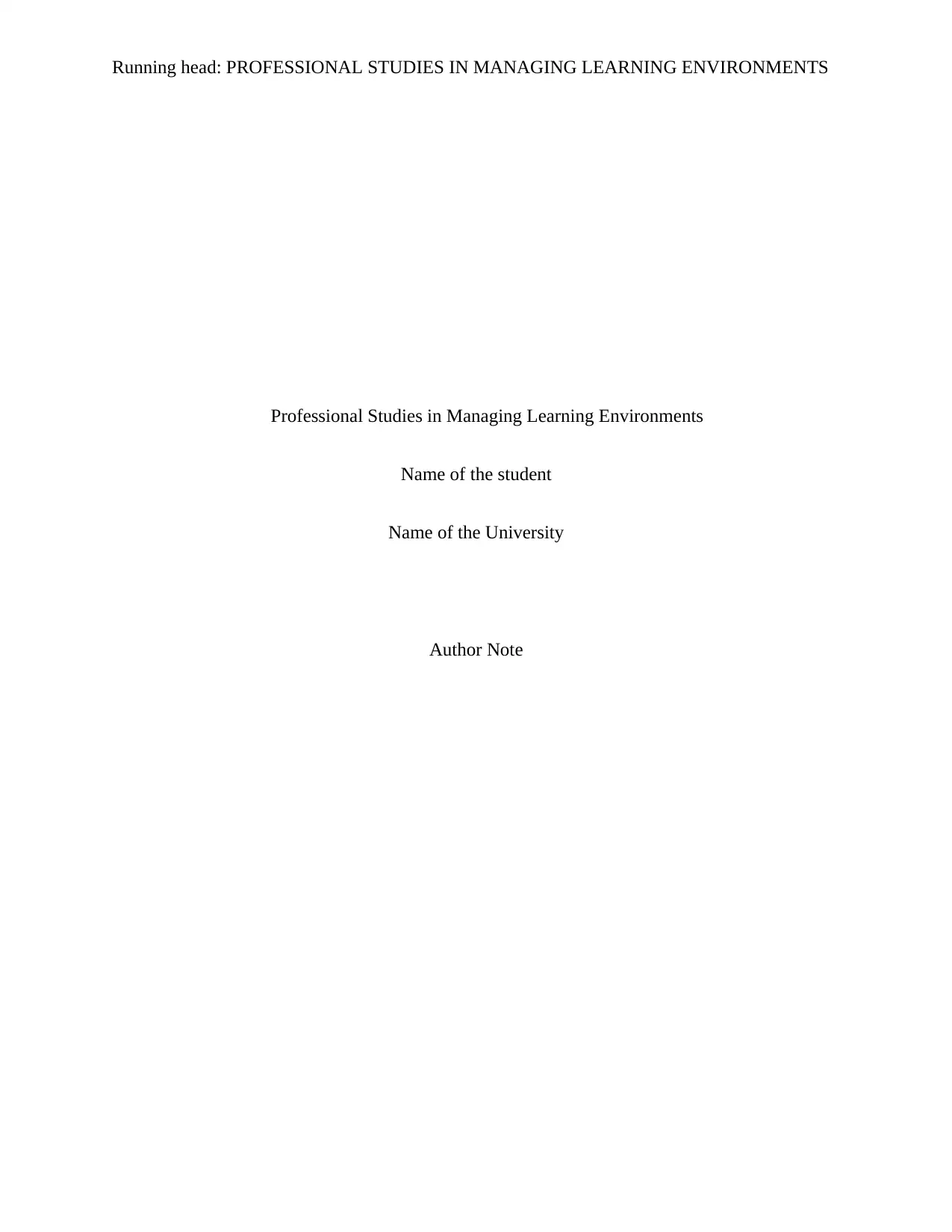
Running head: PROFESSIONAL STUDIES IN MANAGING LEARNING ENVIRONMENTS
Professional Studies in Managing Learning Environments
Name of the student
Name of the University
Author Note
Professional Studies in Managing Learning Environments
Name of the student
Name of the University
Author Note
Paraphrase This Document
Need a fresh take? Get an instant paraphrase of this document with our AI Paraphraser
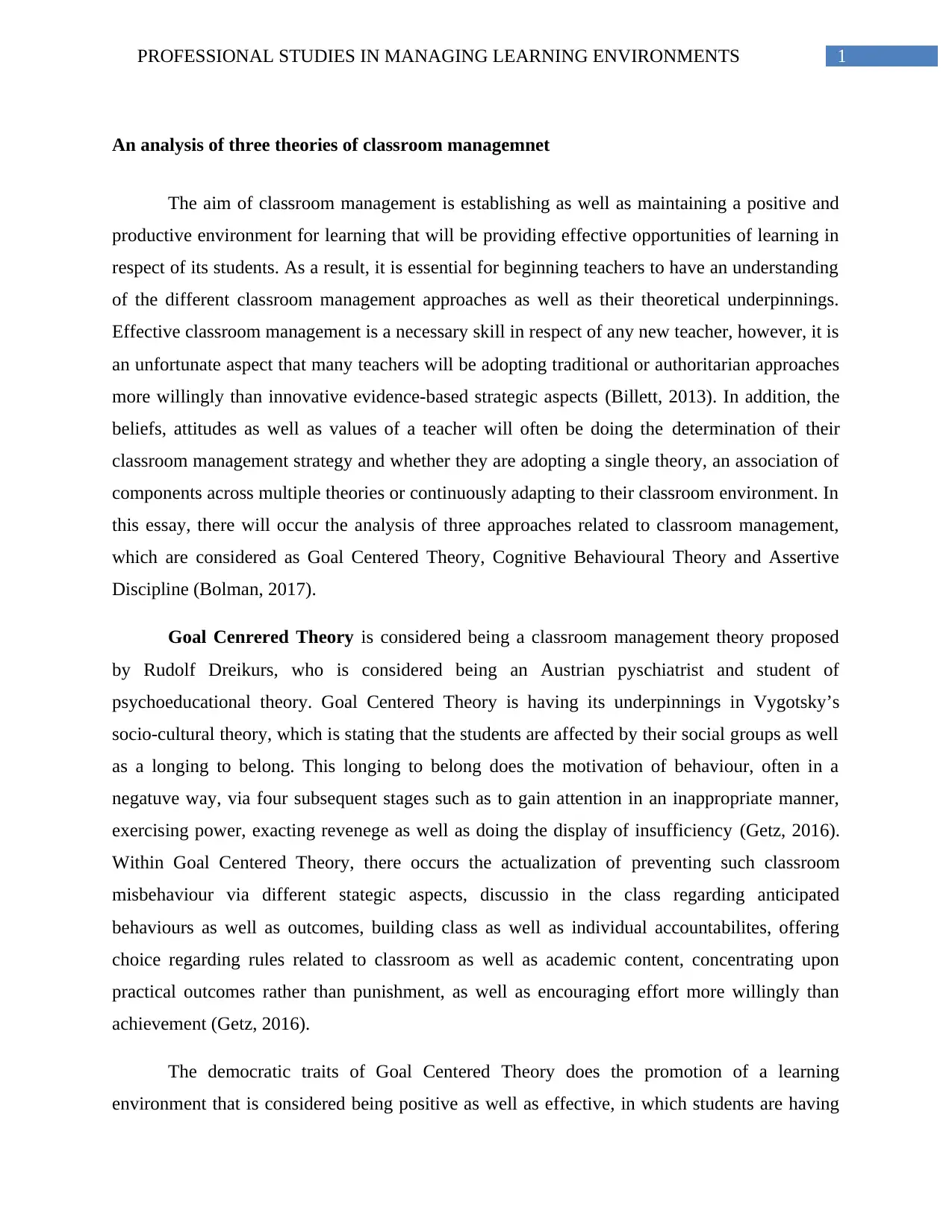
1PROFESSIONAL STUDIES IN MANAGING LEARNING ENVIRONMENTS
An analysis of three theories of classroom managemnet
The aim of classroom management is establishing as well as maintaining a positive and
productive environment for learning that will be providing effective opportunities of learning in
respect of its students. As a result, it is essential for beginning teachers to have an understanding
of the different classroom management approaches as well as their theoretical underpinnings.
Effective classroom management is a necessary skill in respect of any new teacher, however, it is
an unfortunate aspect that many teachers will be adopting traditional or authoritarian approaches
more willingly than innovative evidence-based strategic aspects (Billett, 2013). In addition, the
beliefs, attitudes as well as values of a teacher will often be doing the determination of their
classroom management strategy and whether they are adopting a single theory, an association of
components across multiple theories or continuously adapting to their classroom environment. In
this essay, there will occur the analysis of three approaches related to classroom management,
which are considered as Goal Centered Theory, Cognitive Behavioural Theory and Assertive
Discipline (Bolman, 2017).
Goal Cenrered Theory is considered being a classroom management theory proposed
by Rudolf Dreikurs, who is considered being an Austrian pyschiatrist and student of
psychoeducational theory. Goal Centered Theory is having its underpinnings in Vygotsky’s
socio-cultural theory, which is stating that the students are affected by their social groups as well
as a longing to belong. This longing to belong does the motivation of behaviour, often in a
negatuve way, via four subsequent stages such as to gain attention in an inappropriate manner,
exercising power, exacting revenege as well as doing the display of insufficiency (Getz, 2016).
Within Goal Centered Theory, there occurs the actualization of preventing such classroom
misbehaviour via different stategic aspects, discussio in the class regarding anticipated
behaviours as well as outcomes, building class as well as individual accountabilites, offering
choice regarding rules related to classroom as well as academic content, concentrating upon
practical outcomes rather than punishment, as well as encouraging effort more willingly than
achievement (Getz, 2016).
The democratic traits of Goal Centered Theory does the promotion of a learning
environment that is considered being positive as well as effective, in which students are having
An analysis of three theories of classroom managemnet
The aim of classroom management is establishing as well as maintaining a positive and
productive environment for learning that will be providing effective opportunities of learning in
respect of its students. As a result, it is essential for beginning teachers to have an understanding
of the different classroom management approaches as well as their theoretical underpinnings.
Effective classroom management is a necessary skill in respect of any new teacher, however, it is
an unfortunate aspect that many teachers will be adopting traditional or authoritarian approaches
more willingly than innovative evidence-based strategic aspects (Billett, 2013). In addition, the
beliefs, attitudes as well as values of a teacher will often be doing the determination of their
classroom management strategy and whether they are adopting a single theory, an association of
components across multiple theories or continuously adapting to their classroom environment. In
this essay, there will occur the analysis of three approaches related to classroom management,
which are considered as Goal Centered Theory, Cognitive Behavioural Theory and Assertive
Discipline (Bolman, 2017).
Goal Cenrered Theory is considered being a classroom management theory proposed
by Rudolf Dreikurs, who is considered being an Austrian pyschiatrist and student of
psychoeducational theory. Goal Centered Theory is having its underpinnings in Vygotsky’s
socio-cultural theory, which is stating that the students are affected by their social groups as well
as a longing to belong. This longing to belong does the motivation of behaviour, often in a
negatuve way, via four subsequent stages such as to gain attention in an inappropriate manner,
exercising power, exacting revenege as well as doing the display of insufficiency (Getz, 2016).
Within Goal Centered Theory, there occurs the actualization of preventing such classroom
misbehaviour via different stategic aspects, discussio in the class regarding anticipated
behaviours as well as outcomes, building class as well as individual accountabilites, offering
choice regarding rules related to classroom as well as academic content, concentrating upon
practical outcomes rather than punishment, as well as encouraging effort more willingly than
achievement (Getz, 2016).
The democratic traits of Goal Centered Theory does the promotion of a learning
environment that is considered being positive as well as effective, in which students are having
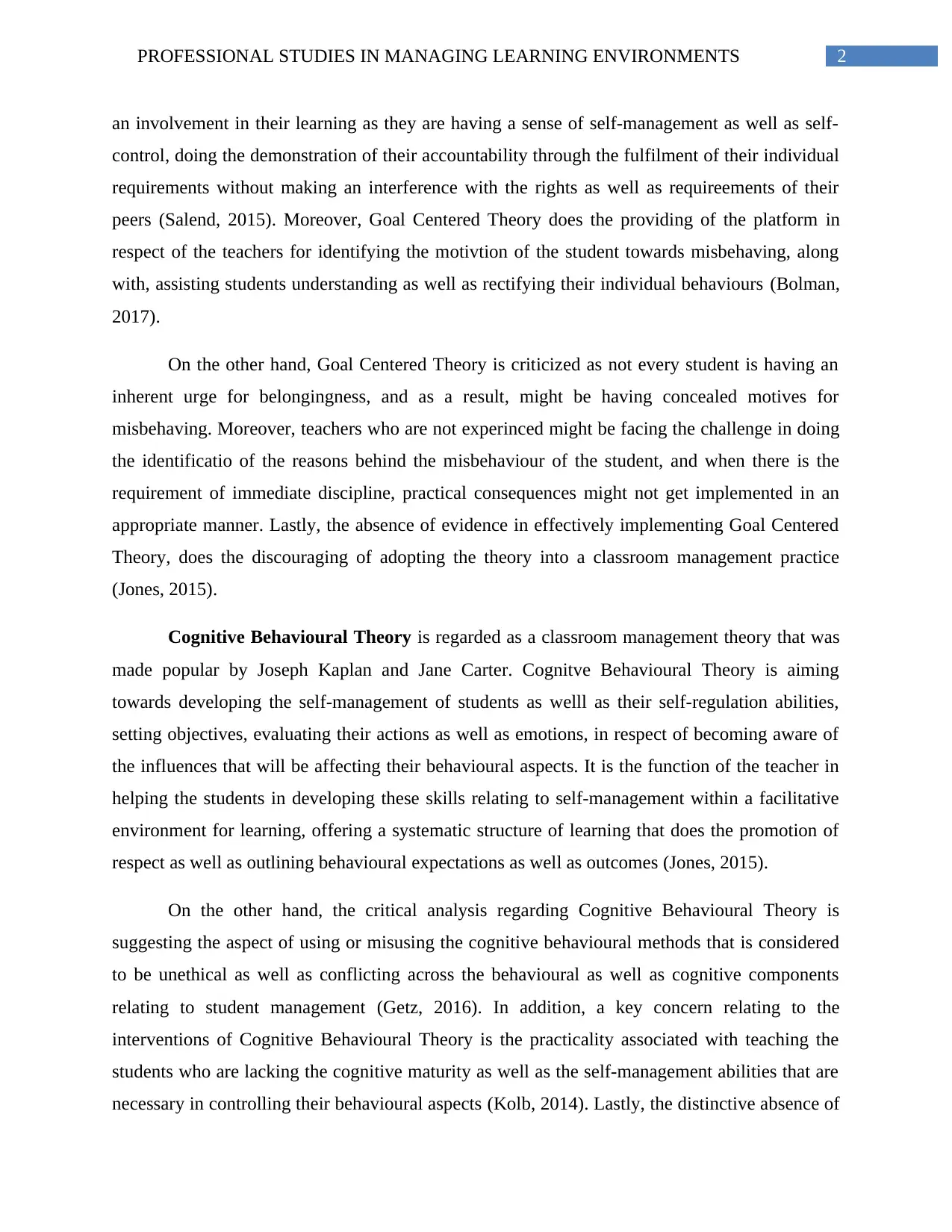
2PROFESSIONAL STUDIES IN MANAGING LEARNING ENVIRONMENTS
an involvement in their learning as they are having a sense of self-management as well as self-
control, doing the demonstration of their accountability through the fulfilment of their individual
requirements without making an interference with the rights as well as requireements of their
peers (Salend, 2015). Moreover, Goal Centered Theory does the providing of the platform in
respect of the teachers for identifying the motivtion of the student towards misbehaving, along
with, assisting students understanding as well as rectifying their individual behaviours (Bolman,
2017).
On the other hand, Goal Centered Theory is criticized as not every student is having an
inherent urge for belongingness, and as a result, might be having concealed motives for
misbehaving. Moreover, teachers who are not experinced might be facing the challenge in doing
the identificatio of the reasons behind the misbehaviour of the student, and when there is the
requirement of immediate discipline, practical consequences might not get implemented in an
appropriate manner. Lastly, the absence of evidence in effectively implementing Goal Centered
Theory, does the discouraging of adopting the theory into a classroom management practice
(Jones, 2015).
Cognitive Behavioural Theory is regarded as a classroom management theory that was
made popular by Joseph Kaplan and Jane Carter. Cognitve Behavioural Theory is aiming
towards developing the self-management of students as welll as their self-regulation abilities,
setting objectives, evaluating their actions as well as emotions, in respect of becoming aware of
the influences that will be affecting their behavioural aspects. It is the function of the teacher in
helping the students in developing these skills relating to self-management within a facilitative
environment for learning, offering a systematic structure of learning that does the promotion of
respect as well as outlining behavioural expectations as well as outcomes (Jones, 2015).
On the other hand, the critical analysis regarding Cognitive Behavioural Theory is
suggesting the aspect of using or misusing the cognitive behavioural methods that is considered
to be unethical as well as conflicting across the behavioural as well as cognitive components
relating to student management (Getz, 2016). In addition, a key concern relating to the
interventions of Cognitive Behavioural Theory is the practicality associated with teaching the
students who are lacking the cognitive maturity as well as the self-management abilities that are
necessary in controlling their behavioural aspects (Kolb, 2014). Lastly, the distinctive absence of
an involvement in their learning as they are having a sense of self-management as well as self-
control, doing the demonstration of their accountability through the fulfilment of their individual
requirements without making an interference with the rights as well as requireements of their
peers (Salend, 2015). Moreover, Goal Centered Theory does the providing of the platform in
respect of the teachers for identifying the motivtion of the student towards misbehaving, along
with, assisting students understanding as well as rectifying their individual behaviours (Bolman,
2017).
On the other hand, Goal Centered Theory is criticized as not every student is having an
inherent urge for belongingness, and as a result, might be having concealed motives for
misbehaving. Moreover, teachers who are not experinced might be facing the challenge in doing
the identificatio of the reasons behind the misbehaviour of the student, and when there is the
requirement of immediate discipline, practical consequences might not get implemented in an
appropriate manner. Lastly, the absence of evidence in effectively implementing Goal Centered
Theory, does the discouraging of adopting the theory into a classroom management practice
(Jones, 2015).
Cognitive Behavioural Theory is regarded as a classroom management theory that was
made popular by Joseph Kaplan and Jane Carter. Cognitve Behavioural Theory is aiming
towards developing the self-management of students as welll as their self-regulation abilities,
setting objectives, evaluating their actions as well as emotions, in respect of becoming aware of
the influences that will be affecting their behavioural aspects. It is the function of the teacher in
helping the students in developing these skills relating to self-management within a facilitative
environment for learning, offering a systematic structure of learning that does the promotion of
respect as well as outlining behavioural expectations as well as outcomes (Jones, 2015).
On the other hand, the critical analysis regarding Cognitive Behavioural Theory is
suggesting the aspect of using or misusing the cognitive behavioural methods that is considered
to be unethical as well as conflicting across the behavioural as well as cognitive components
relating to student management (Getz, 2016). In addition, a key concern relating to the
interventions of Cognitive Behavioural Theory is the practicality associated with teaching the
students who are lacking the cognitive maturity as well as the self-management abilities that are
necessary in controlling their behavioural aspects (Kolb, 2014). Lastly, the distinctive absence of
⊘ This is a preview!⊘
Do you want full access?
Subscribe today to unlock all pages.

Trusted by 1+ million students worldwide
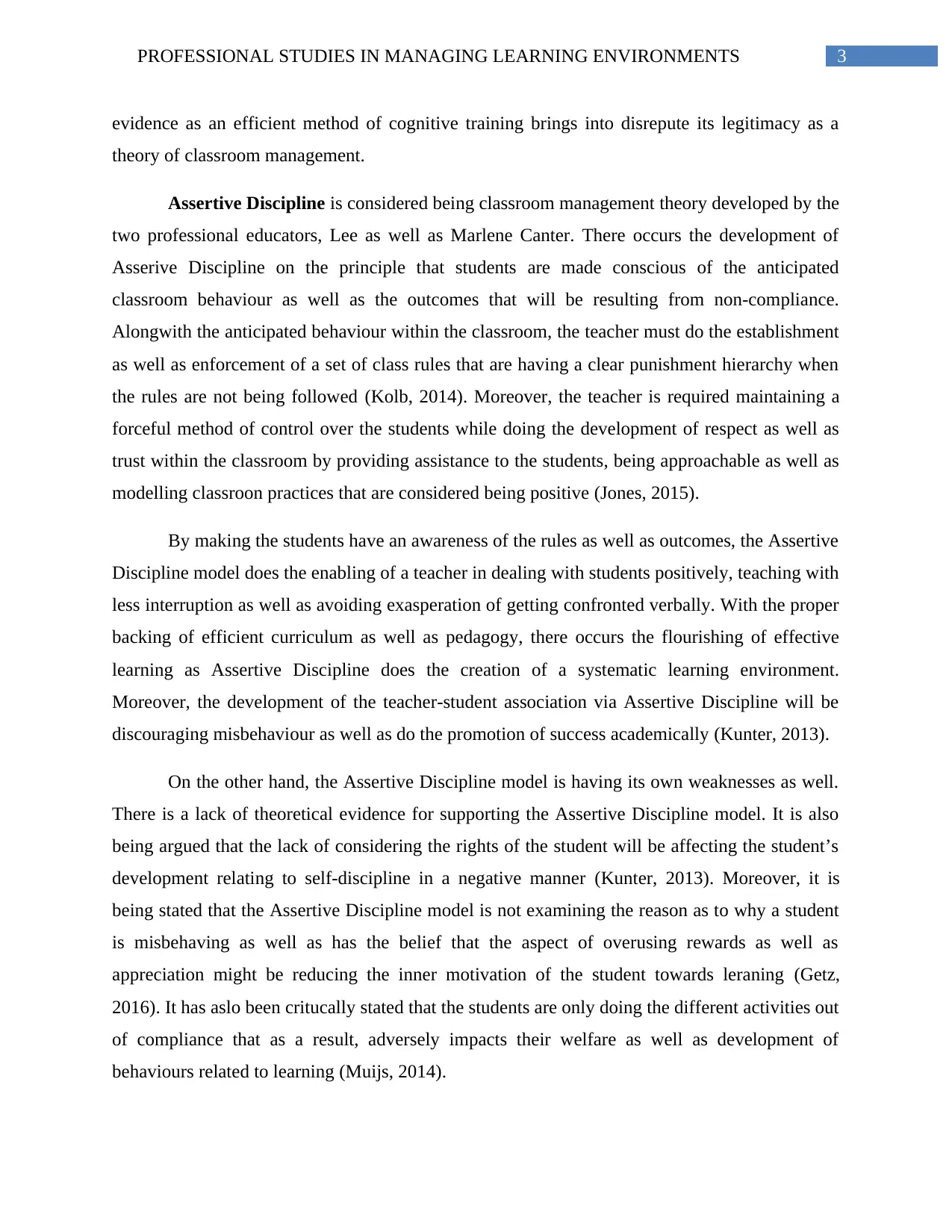
3PROFESSIONAL STUDIES IN MANAGING LEARNING ENVIRONMENTS
evidence as an efficient method of cognitive training brings into disrepute its legitimacy as a
theory of classroom management.
Assertive Discipline is considered being classroom management theory developed by the
two professional educators, Lee as well as Marlene Canter. There occurs the development of
Asserive Discipline on the principle that students are made conscious of the anticipated
classroom behaviour as well as the outcomes that will be resulting from non-compliance.
Alongwith the anticipated behaviour within the classroom, the teacher must do the establishment
as well as enforcement of a set of class rules that are having a clear punishment hierarchy when
the rules are not being followed (Kolb, 2014). Moreover, the teacher is required maintaining a
forceful method of control over the students while doing the development of respect as well as
trust within the classroom by providing assistance to the students, being approachable as well as
modelling classroon practices that are considered being positive (Jones, 2015).
By making the students have an awareness of the rules as well as outcomes, the Assertive
Discipline model does the enabling of a teacher in dealing with students positively, teaching with
less interruption as well as avoiding exasperation of getting confronted verbally. With the proper
backing of efficient curriculum as well as pedagogy, there occurs the flourishing of effective
learning as Assertive Discipline does the creation of a systematic learning environment.
Moreover, the development of the teacher-student association via Assertive Discipline will be
discouraging misbehaviour as well as do the promotion of success academically (Kunter, 2013).
On the other hand, the Assertive Discipline model is having its own weaknesses as well.
There is a lack of theoretical evidence for supporting the Assertive Discipline model. It is also
being argued that the lack of considering the rights of the student will be affecting the student’s
development relating to self-discipline in a negative manner (Kunter, 2013). Moreover, it is
being stated that the Assertive Discipline model is not examining the reason as to why a student
is misbehaving as well as has the belief that the aspect of overusing rewards as well as
appreciation might be reducing the inner motivation of the student towards leraning (Getz,
2016). It has aslo been critucally stated that the students are only doing the different activities out
of compliance that as a result, adversely impacts their welfare as well as development of
behaviours related to learning (Muijs, 2014).
evidence as an efficient method of cognitive training brings into disrepute its legitimacy as a
theory of classroom management.
Assertive Discipline is considered being classroom management theory developed by the
two professional educators, Lee as well as Marlene Canter. There occurs the development of
Asserive Discipline on the principle that students are made conscious of the anticipated
classroom behaviour as well as the outcomes that will be resulting from non-compliance.
Alongwith the anticipated behaviour within the classroom, the teacher must do the establishment
as well as enforcement of a set of class rules that are having a clear punishment hierarchy when
the rules are not being followed (Kolb, 2014). Moreover, the teacher is required maintaining a
forceful method of control over the students while doing the development of respect as well as
trust within the classroom by providing assistance to the students, being approachable as well as
modelling classroon practices that are considered being positive (Jones, 2015).
By making the students have an awareness of the rules as well as outcomes, the Assertive
Discipline model does the enabling of a teacher in dealing with students positively, teaching with
less interruption as well as avoiding exasperation of getting confronted verbally. With the proper
backing of efficient curriculum as well as pedagogy, there occurs the flourishing of effective
learning as Assertive Discipline does the creation of a systematic learning environment.
Moreover, the development of the teacher-student association via Assertive Discipline will be
discouraging misbehaviour as well as do the promotion of success academically (Kunter, 2013).
On the other hand, the Assertive Discipline model is having its own weaknesses as well.
There is a lack of theoretical evidence for supporting the Assertive Discipline model. It is also
being argued that the lack of considering the rights of the student will be affecting the student’s
development relating to self-discipline in a negative manner (Kunter, 2013). Moreover, it is
being stated that the Assertive Discipline model is not examining the reason as to why a student
is misbehaving as well as has the belief that the aspect of overusing rewards as well as
appreciation might be reducing the inner motivation of the student towards leraning (Getz,
2016). It has aslo been critucally stated that the students are only doing the different activities out
of compliance that as a result, adversely impacts their welfare as well as development of
behaviours related to learning (Muijs, 2014).
Paraphrase This Document
Need a fresh take? Get an instant paraphrase of this document with our AI Paraphraser
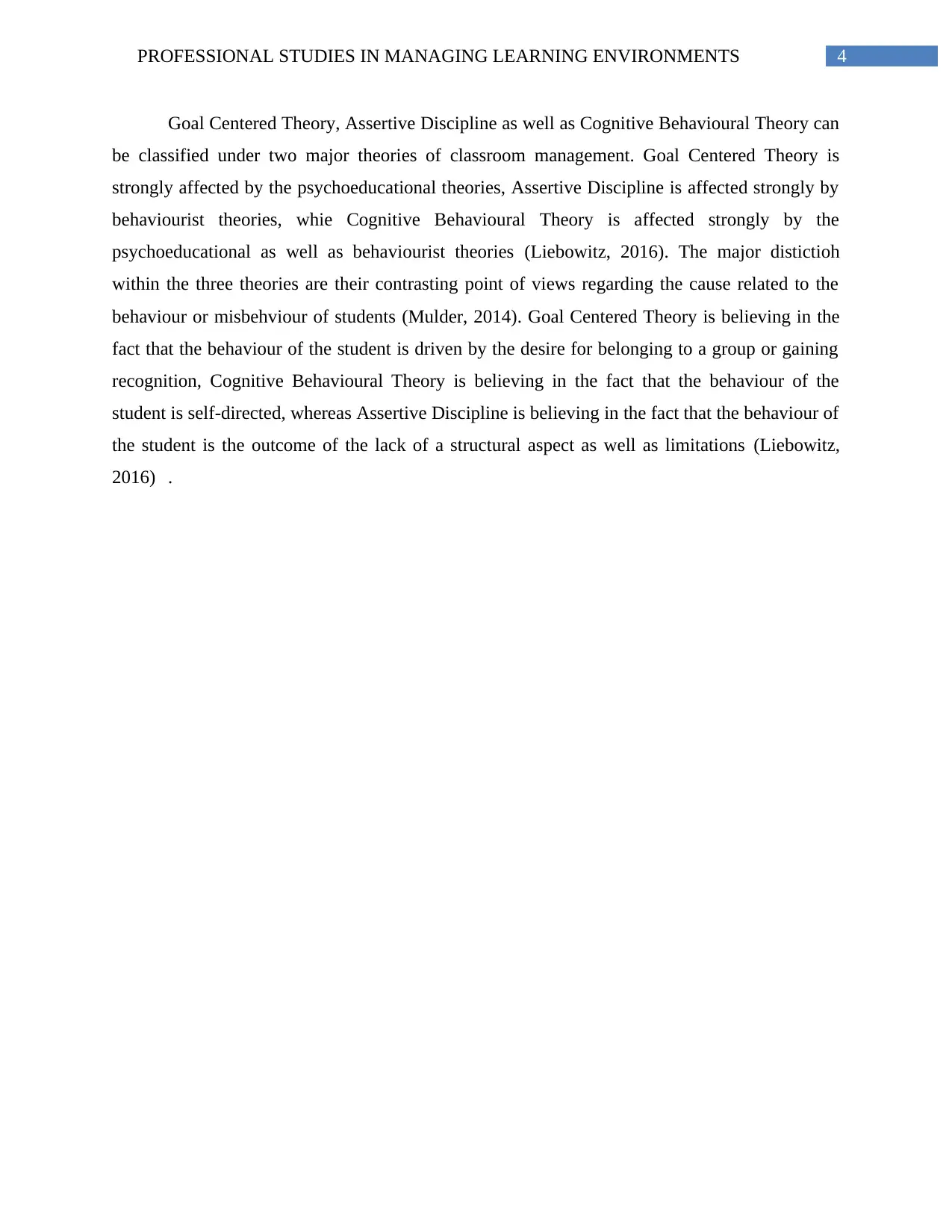
4PROFESSIONAL STUDIES IN MANAGING LEARNING ENVIRONMENTS
Goal Centered Theory, Assertive Discipline as well as Cognitive Behavioural Theory can
be classified under two major theories of classroom management. Goal Centered Theory is
strongly affected by the psychoeducational theories, Assertive Discipline is affected strongly by
behaviourist theories, whie Cognitive Behavioural Theory is affected strongly by the
psychoeducational as well as behaviourist theories (Liebowitz, 2016). The major distictioh
within the three theories are their contrasting point of views regarding the cause related to the
behaviour or misbehviour of students (Mulder, 2014). Goal Centered Theory is believing in the
fact that the behaviour of the student is driven by the desire for belonging to a group or gaining
recognition, Cognitive Behavioural Theory is believing in the fact that the behaviour of the
student is self-directed, whereas Assertive Discipline is believing in the fact that the behaviour of
the student is the outcome of the lack of a structural aspect as well as limitations (Liebowitz,
2016) .
Goal Centered Theory, Assertive Discipline as well as Cognitive Behavioural Theory can
be classified under two major theories of classroom management. Goal Centered Theory is
strongly affected by the psychoeducational theories, Assertive Discipline is affected strongly by
behaviourist theories, whie Cognitive Behavioural Theory is affected strongly by the
psychoeducational as well as behaviourist theories (Liebowitz, 2016). The major distictioh
within the three theories are their contrasting point of views regarding the cause related to the
behaviour or misbehviour of students (Mulder, 2014). Goal Centered Theory is believing in the
fact that the behaviour of the student is driven by the desire for belonging to a group or gaining
recognition, Cognitive Behavioural Theory is believing in the fact that the behaviour of the
student is self-directed, whereas Assertive Discipline is believing in the fact that the behaviour of
the student is the outcome of the lack of a structural aspect as well as limitations (Liebowitz,
2016) .
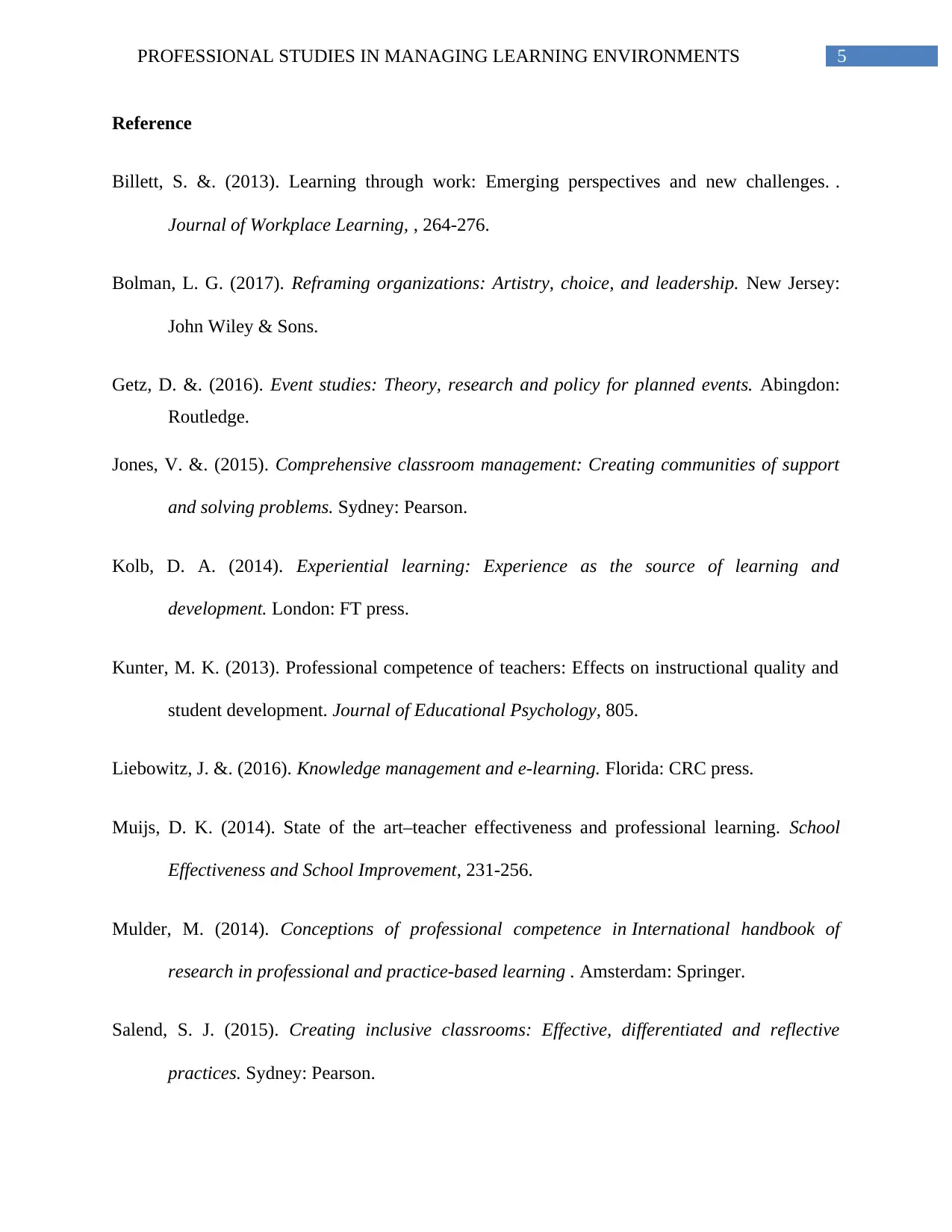
5PROFESSIONAL STUDIES IN MANAGING LEARNING ENVIRONMENTS
Reference
Billett, S. &. (2013). Learning through work: Emerging perspectives and new challenges. .
Journal of Workplace Learning, , 264-276.
Bolman, L. G. (2017). Reframing organizations: Artistry, choice, and leadership. New Jersey:
John Wiley & Sons.
Getz, D. &. (2016). Event studies: Theory, research and policy for planned events. Abingdon:
Routledge.
Jones, V. &. (2015). Comprehensive classroom management: Creating communities of support
and solving problems. Sydney: Pearson.
Kolb, D. A. (2014). Experiential learning: Experience as the source of learning and
development. London: FT press.
Kunter, M. K. (2013). Professional competence of teachers: Effects on instructional quality and
student development. Journal of Educational Psychology, 805.
Liebowitz, J. &. (2016). Knowledge management and e-learning. Florida: CRC press.
Muijs, D. K. (2014). State of the art–teacher effectiveness and professional learning. School
Effectiveness and School Improvement, 231-256.
Mulder, M. (2014). Conceptions of professional competence in International handbook of
research in professional and practice-based learning . Amsterdam: Springer.
Salend, S. J. (2015). Creating inclusive classrooms: Effective, differentiated and reflective
practices. Sydney: Pearson.
Reference
Billett, S. &. (2013). Learning through work: Emerging perspectives and new challenges. .
Journal of Workplace Learning, , 264-276.
Bolman, L. G. (2017). Reframing organizations: Artistry, choice, and leadership. New Jersey:
John Wiley & Sons.
Getz, D. &. (2016). Event studies: Theory, research and policy for planned events. Abingdon:
Routledge.
Jones, V. &. (2015). Comprehensive classroom management: Creating communities of support
and solving problems. Sydney: Pearson.
Kolb, D. A. (2014). Experiential learning: Experience as the source of learning and
development. London: FT press.
Kunter, M. K. (2013). Professional competence of teachers: Effects on instructional quality and
student development. Journal of Educational Psychology, 805.
Liebowitz, J. &. (2016). Knowledge management and e-learning. Florida: CRC press.
Muijs, D. K. (2014). State of the art–teacher effectiveness and professional learning. School
Effectiveness and School Improvement, 231-256.
Mulder, M. (2014). Conceptions of professional competence in International handbook of
research in professional and practice-based learning . Amsterdam: Springer.
Salend, S. J. (2015). Creating inclusive classrooms: Effective, differentiated and reflective
practices. Sydney: Pearson.
⊘ This is a preview!⊘
Do you want full access?
Subscribe today to unlock all pages.

Trusted by 1+ million students worldwide
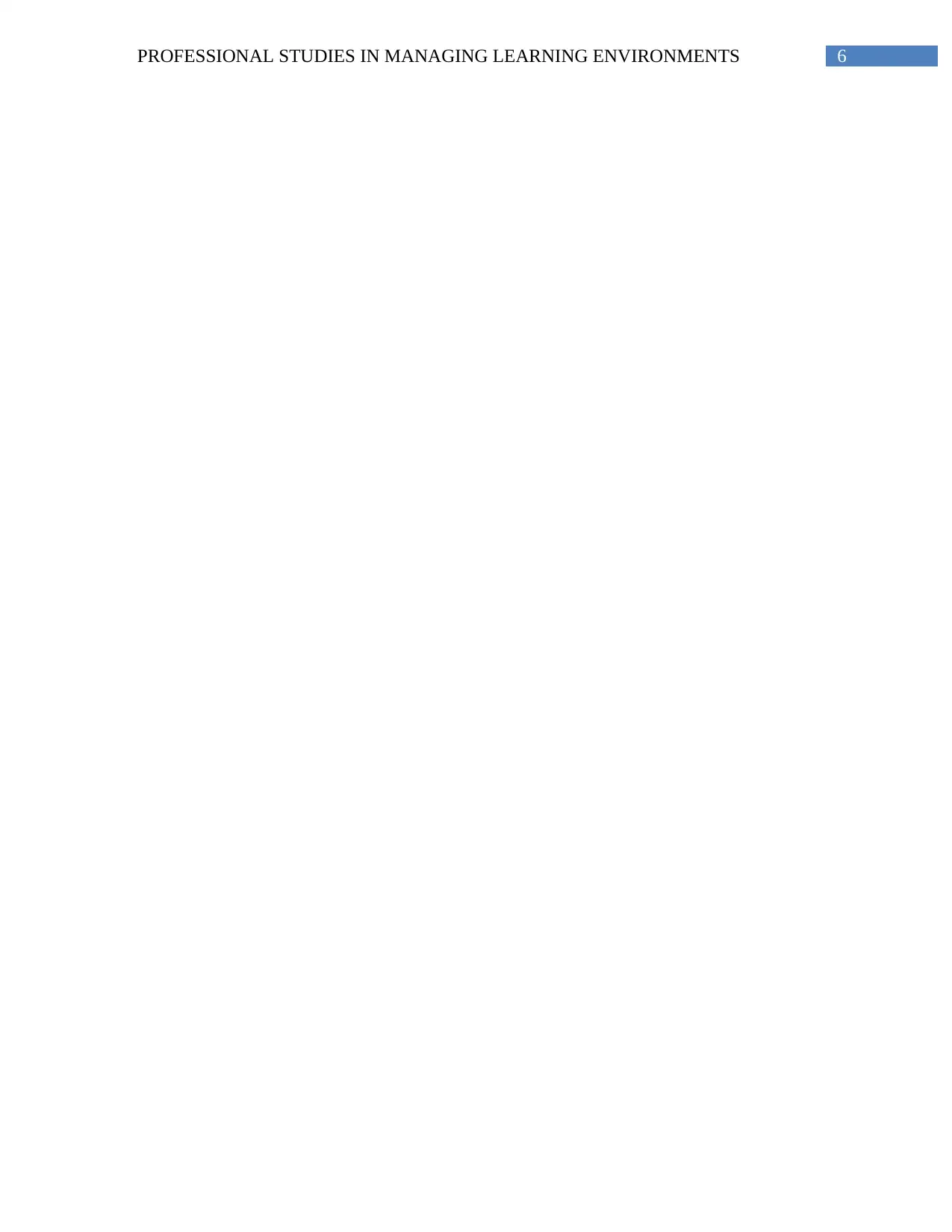
6PROFESSIONAL STUDIES IN MANAGING LEARNING ENVIRONMENTS
1 out of 7
Related Documents
Your All-in-One AI-Powered Toolkit for Academic Success.
+13062052269
info@desklib.com
Available 24*7 on WhatsApp / Email
![[object Object]](/_next/static/media/star-bottom.7253800d.svg)
Unlock your academic potential
Copyright © 2020–2025 A2Z Services. All Rights Reserved. Developed and managed by ZUCOL.





